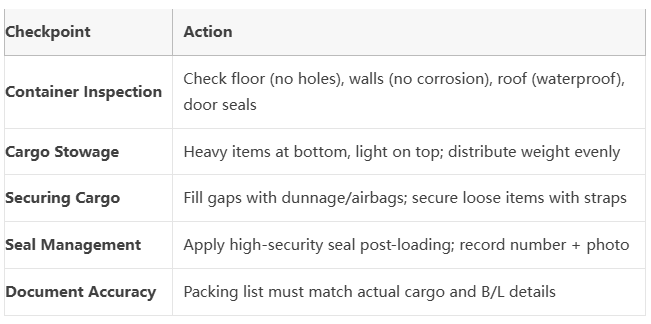1.1 Booking & Documentation
Provide details: Origin/destination ports, cargo description (type/gross weight/volume), container size, HS code, sailing date
Get quote: Ocean freight + surcharges (THC, DOC, BUC, etc.)
Submit booking request: Receive booking confirmation with B/L number and Shipping Order (S/O)
1.2 Container Pickup & Loading
Pick up empty container:
✓ Inspect for damage/rust, cleanliness, door seals (photo evidence recommended)
Load cargo: Follow Section 3 loading standards
Submit VGM: Weigh loaded container before deadline (SOLAS requirement)
1.3 Customs Clearance
Submit documents: Commercial invoice, packing list, customs declaration
Verify draft Bill of Lading (shipper/consignee details, cargo info, seal numbers)
Obtain customs release
1.4 Port Delivery & Loading
Deliver loaded container to port before cut-off time
Vessel departure → Original B/L issued
1.5 Destination Process
Consignee clears customs using B/L
Pay destination charges (THC, demurrage, etc.)
Exchange B/L for Delivery Order (D/O) → Collect cargo
Critical: Return empty container within free time to avoid detention fees
2.1 Mandatory Protocols

2.2 Prohibited Practices
⚠️ Skipping container inspection → Unreported damage = liability risk
⚠️ Overloading/oversizing:
Max weight: 21.7T for 20GP, 26.5T for 40HQ (check MAX GROSS on container door)
Height/width must fit container dimensions (use HQ for tall items)
⚠️ Unbalanced weight: >60% weight on one side risks tipping
⚠️ Mixing incompatible goods: e.g., chemicals + food (unless properly segregated)
⚠️ Misdeclaring cargo: Undisclosed batteries/liquids/dangerous goods = penalties
Deadlines: Track VGM cutoff, port cut-off, and customs clearance times
Weight Compliance:
Verify road weight limits (e.g., US max 36T for 40HQ)
Dangerous Goods (DG):
✓ Submit MSDS + DG Declaration Form
✓ Apply IMDG Code labels externally
Pro Tip: Book 4-6 weeks ahead during peak seasons; partner with Tier-1 NVOCCs for contingency support